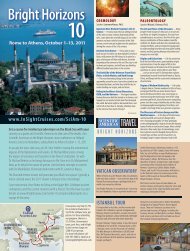Croatian cultural heritage - Business - Hrvatska turistiÄka zajednica
Croatian cultural heritage - Business - Hrvatska turistiÄka zajednica
Croatian cultural heritage - Business - Hrvatska turistiÄka zajednica
Create successful ePaper yourself
Turn your PDF publications into a flip-book with our unique Google optimized e-Paper software.
9<br />
Unfortunately, the importance of traffic and flat landscapes<br />
has always made Slavonia attractive for big conquering armies,<br />
and in almost every major war, this area was exposed<br />
to heavy destruction. It was especially devestating in the<br />
Second World War, when at Batina on the Danube, one of<br />
the biggest battles between the Nazis and the Soviet Red<br />
Army took place. In memory of the battle, there stands a<br />
monument by the <strong>Croatian</strong> sculptor Antun Augustinčić<br />
(6).<br />
Of all the parts of Croatia, Slavonia suffered most in the<br />
Homeland War, especially the city of Vukovar. This heroic<br />
city was almost completely destroyed by the former Yugoslav<br />
People's Army which conducted the biggest genocide<br />
in Europe since the Second World War, as evidenced by the<br />
memorial area Ovčara and a monument to Vukovar's heroes<br />
at the cemetery (7).<br />
During the Homeland War, the largest Slavonian city of Osijek<br />
also suffered great damages, but it has now been almost<br />
completely restored. Along the river Drava we can find its<br />
characteristic TOWN PALACES, such as the one in which<br />
the main city theatre is located (12). The area is dominated<br />
by the Cathedral of St. Peter and Paul (9) near the main<br />
square, the Square of Ante Starčević (10).<br />
Monumental palaces also adorn other Slavonian towns,<br />
such as Vinkovci (11), Vukovar (20), Virovitica (14), Slavonski<br />
Brod (15 & 18) and especially Požega (13 & 16). The<br />
latter is important because it has one of the most beautiful<br />
squares in Croatia (19), although the people of Slavonski<br />
Brod (17), today the second largest Slavonian town, are unlikely<br />
to agree with this.<br />
However, the Osijek Fort represents the most important<br />
Baroque <strong>heritage</strong> of Slavonia. This unique combination of a<br />
military fort and the city, in which normal civil life was led,<br />
was founded in 1712 and was modeled on Dutch military<br />
fortifications. Except for the walls, the Fort has remained in<br />
an almost unchanged condition (32). It is now the University<br />
of Osijek and the Museum of Slavonia (24) and, what is<br />
most interesting, a modern archaeological museum (28 &<br />
29). The Fort is the only <strong>cultural</strong> monument in Slavonia proposed<br />
to be put on the UNESCO list of World Heritage.<br />
Unlike the Osijek Fort, in Slavonski Brod, the former defensive<br />
walls have remained well preserved (27). Like most<br />
68
















